-
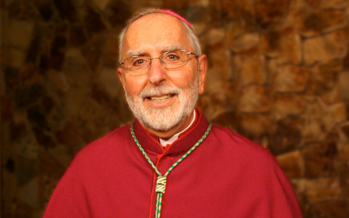 May 13, 2025By Bishop Gerald F. Kicanas
May 13, 2025By Bishop Gerald F. Kicanas
My brothers and sisters in Christ Jesus,
Well, we saw the white smoke coming from the world’s most famous chimney on the top of the Sistine Chapel and we have seen the doors of the Balcony of St. Peter’s Basilica open as the Cardinal came forward to announce, "Anuncio vobis, gaudium magnum, habemos Papam, Roberto Francisco Prevost" and his name will be Pope Leo XIV, An American! Unheard of in history. But what an amazing choice.
I first met Pope Leo XIV almost 30 years ago in Chicago and we continued to correspond with one another when he went to become the Bishop of Chiclayo in Peru. At one point I asked him if he could help us by sending us a Spanish speaking priest because we were in serious need. Without hesitation he told me he would try and sure enough he quickly responded to my plea and sent a priest to serve among us. When that priest returned to his Diocese, then Bishop Prevost sent another priest to replace him. What a great help that was for our Diocese. Those priests were Fr. Rolando Monteza Calderón, who at the time was appointed as Parochial Vicar of Immaculate Conception from October 1, 2015, to February 25, 2019. After Fr. Rolando, Fr. José Martín Uriarte Guevara came from March 25th of 2019 to December 31st, 2023.
As it turns out the story of Pope Leo XIV and the Diocese of Tucson carries an additional twist in our history. In 1999 the Catholic Foundation and the diocese hosted Father Robert Prevost, then the Augustian Provincial. Bishop Manuel Moreno was discussing the possibility of bringing Augustian priests to what is now Saint Augustine High School. At the time, the schedule and projected costs were not feasible. However, our archives prove that Father Prevost, now Pope Leo XIV, did in fact visit our diocese. What an incredible blessing for our diocese.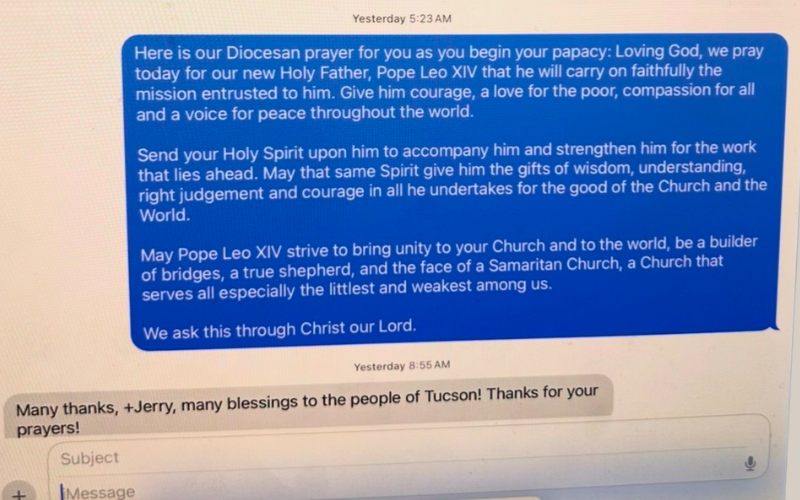 Message from Pope Leo XIV to Bishop Kicanas
Message from Pope Leo XIV to Bishop Kicanas
I have visited with Cardinal Robert Prevost each time I have been in Rome after he was appointed to serve as the Head of the Dicastery of Bishops. His responsibility was to recommend names for bishops throughout the world to the Pope. Even with all those responsibilities, when I wrote to him to see if he had time for a visit while I was in Rome, he never hesitated. My last visit with him was in February. At that time, he was worried about the failing health of Pope Francis but was hopeful he would recover.
Our new Holy Father is a patient, highly competent administrator, reserved but decisive, caring and a great listener. You feel comfortable in his presence and sense he genuinely has an interest in you while you are with him. He loved his Diocese of Chi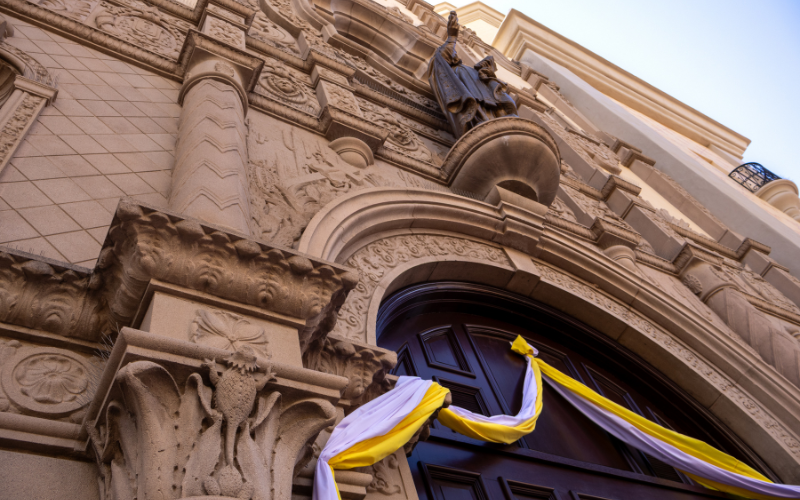 clayo, and it is no wonder that he mentioned his people there in his opening reflection to the world.
clayo, and it is no wonder that he mentioned his people there in his opening reflection to the world.
We will gather as a Diocese to pray for our new Holy Father this coming Sunday, May 18 at 10:00 am at St. Augustine Cathedral. You are most welcome to join us in that celebration. The Fourth Sunday after Easter was Good Shepherd Sunday and now, we have a new Shepherd to lead the Church.
———
This past week we concluded the pilgrimage in the Footsteps of St. Paul with some marvelous experiences. We traveled by boat for the next few days entering Turkey for a brief period and then returning to Greece as we followed Paul in his three missionary journeys.
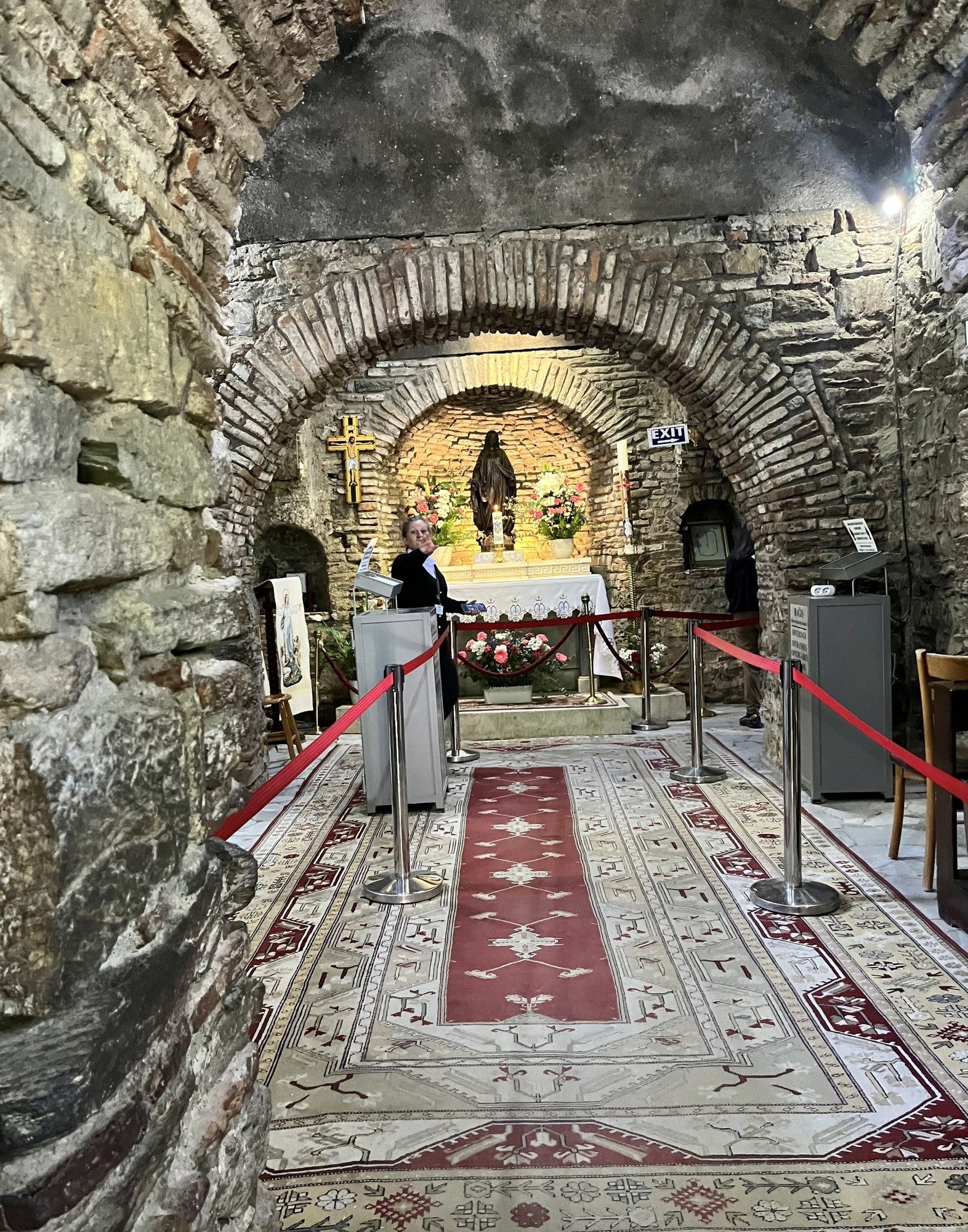
First, Mary’s house, a quiet, tranquil place despite the many tourists. We don’t know for sure that Mary lived in this small place, high in the hills of the town of Kusadasi in Turkey, a strikingly beautiful spot. But tradition suggests she lived there after the crucifixion.
There we held Mass in honor of Mary. In our prayer we remembered our families and blest the women accompanying us. A group of sisters and a few Franciscan Capuchin Friars staff this shrine. Several other Catholic groups were there with their spiritual directors, the Diocese of Wichita with Fr. Dan Duling and the Diocese of Tyler in Texas with Fr. Hank Lanik.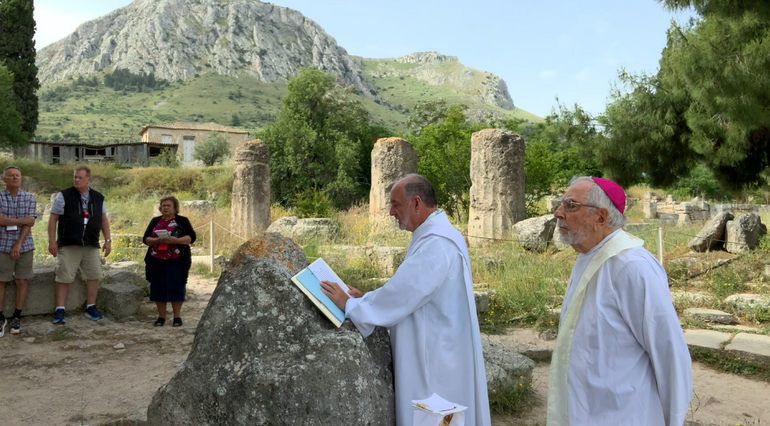
Later we visited the amazing excavation of the ancient city of Ephesus where Paul preached and reminded the Ephesians that their god, Diana, was not a real god. This, of course, angered the silversmiths who made and sold images of Diana, so people could worship their god. These silversmiths fought with Paul that his god was nonsense. Diana is the only god. Despite all his difficulties and challenges Paul kept preaching the Word and the New Way remembering that Jesus suffered, died, was buried and rose again on our behalf.
Ephesus was a bustling town in the days of Paul since it was a port city but gradually the silt from the river made the port unusable and the town failed and over the years was buried underneath lots of soil only to be recently excavated. Today, despite all that has been found, it is estimated that only 10% of the town has been uncovered. While they have not as yet found the synagogue where Paul preached, we did see the library which has been strikingly restored, and it is anticipated that the synagogue could be close by. In Acts, Luke speaks of Paul speaking in the Agora, a meeting place where Ephesians gathered, which one can now see. One could only imagine Paul speaking with confidence and courage.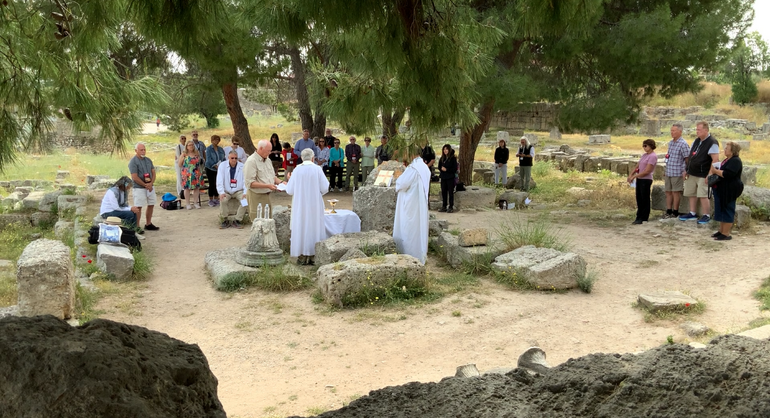
Paul, the zealous Jew, hated the Christians, the New Way. He delighted in the death of Steven, the Protomartyr and dragged-out Christians from their home and handed them over for imprisonment until he met the Lord on the road to Damascus. Paul is often pictured as falling off a horse in his encounter with Christ, but the Scriptures make no mention of a horse. After that, although not an Apostle, he went far and wide inviting others to encounter Christ especially the Gentiles who never met the Lord. One can only marvel at his total conversion from being a persecutor to the one who traveled globally to invite others to a change of heart.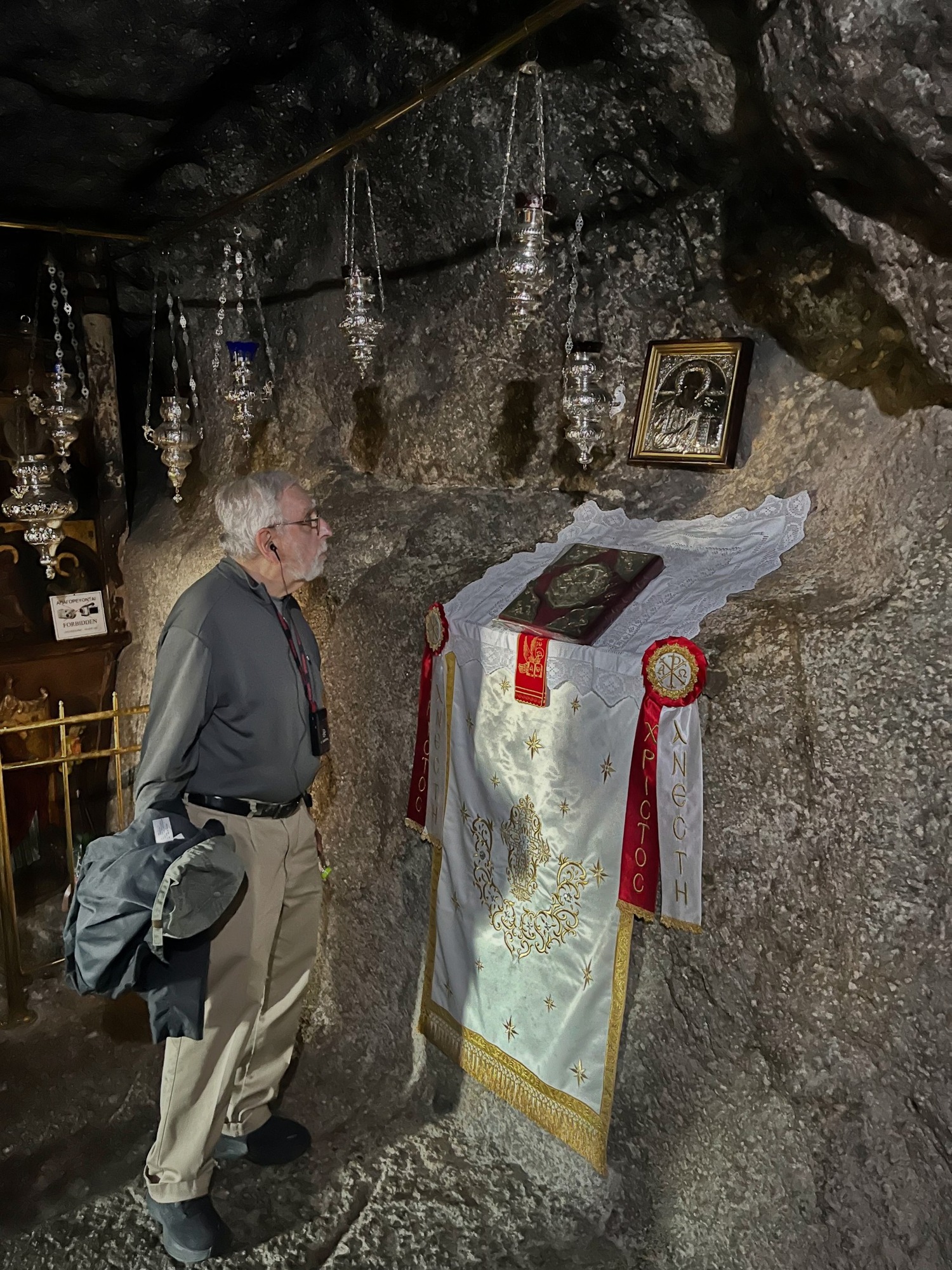
The last part of this incredible day was a trip to Patmos where the scriptures say John the Beloved, the Evangelist, the Disciple, the theologian, lived in a cave where he had visions that he wrote down in the final of the 27 books of the New Testament, the Apocalypse or the Book of Revelation. It is an amazing, mystical place despite all the visitors. One sees the rock where he wrote the book, spelling out his visions. Outside the cave are marvelous views of Patmos by the sea.
Near to the cave is the Monastery of St. John where a group of monks have lived for centuries. The climb up is difficult but well worth the effort and the strain on the knees e specially coming down. The frescoes are mostly original, and it is fascinating to see the rough, worn dining room where the monks ate their simple meals and the chapel where they prayed. That chapel holds relics of monks and heads of two of the monks.
specially coming down. The frescoes are mostly original, and it is fascinating to see the rough, worn dining room where the monks ate their simple meals and the chapel where they prayed. That chapel holds relics of monks and heads of two of the monks.
We continued the cruise stopping in Rhodes, Crete and Santorini. Most of this was tourist area with lots of shops and ancient ruins from bygone days.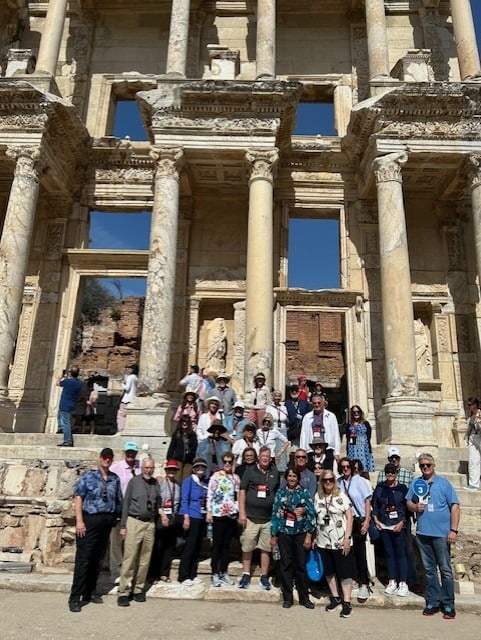
Arriving back in Athens, we rode Northeast to the Pelopensis to visit the site of Corinth about which Paul wrote his two letters. Paul spent eighteen months visiting in Corinth. Here he met Priscilla and Aquila. Here he shared his work of tent making.
Corinth was a very important city for business kind of like New York or Hong Kong. Paul’s custom was to go to the Agora, the marketplace, where many gathered so he could announce the New Way.
We celebrate Mass outside among the remains of this ancient city. The open-air setting was magnificent with a brilliant blue sky and birds chirping as we tried to imagine Paul speaking here, his voice powerfully proclaiming the Christ who suffered, died and was buried and rose from the dead.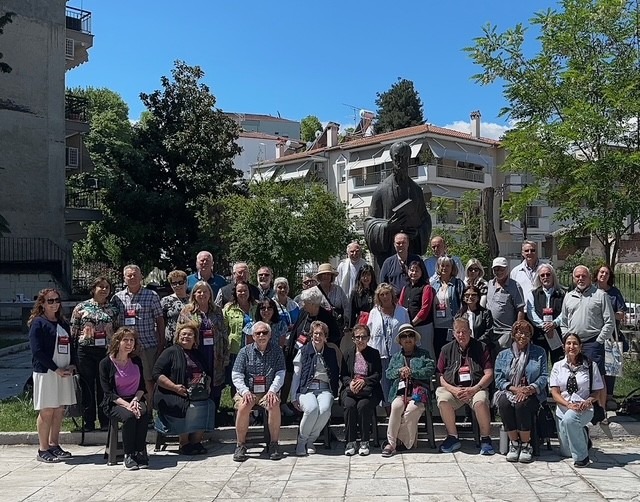
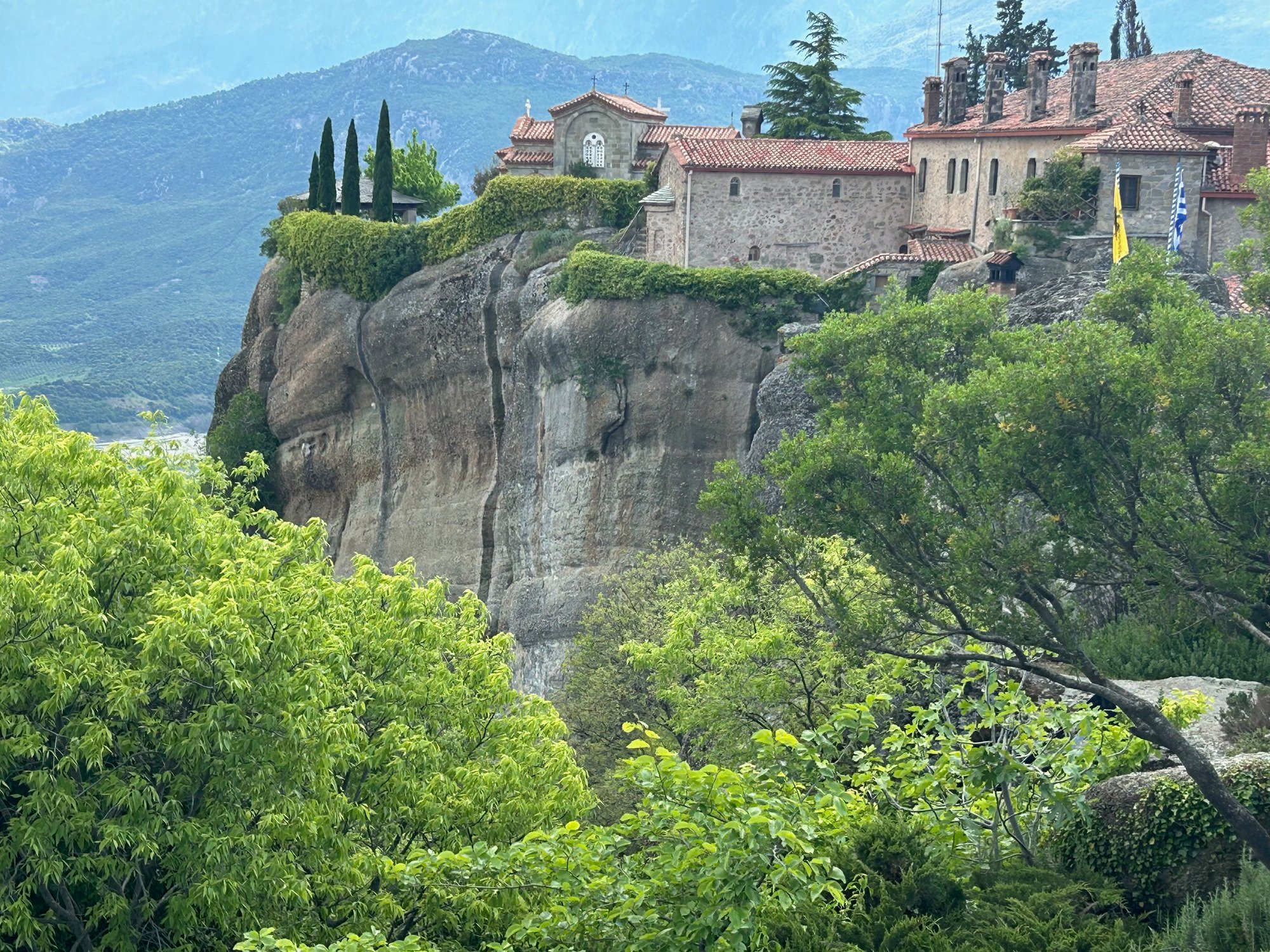
———
This week we begin interviewing candidates for a position that includes responsibilities of the Chancellor and some of the responsibilities of the Moderator of the Curia. After consultation with the College of Consultors, it seems important that we have laity serving in significant positions and roles not necessarily requiring priestly ordination. The Diocese will also be considering having deacons serve as pastoral administrators with a priest serving as a sacramental minister.
———
This week there are a number of our Catholic High Schools that will be celebrating graduation. I will be celebrating the Graduation Mass for St. Augustine and San Miguel. Barbara Monsegur will be leaving as principal, and we are grateful for her dedicated service. Fr. Carl Markels, O. Carm, the provincial of the Carmelite Fathers, will be celebrating the Mass for Salpointe Catholic High School’s graduation, as they bid farewell to Kay Sulllivan who has served as President of Salpointe for many years and helped raise enormous sums of money to enhance the facility. We express gratitude for her service. Our other Catholic High Schools, Lourdes and Yuma Catholic will also be celebrating Masses for their graduates.
Let me take this occasion at the end of a school year to thank all our administrators, faculty and staff of our Catholic grade and high schools for all they do to provide quality education for children and young people in our Catholic Schools. Parents, too, deserve our thanks for sacrificing to send their children to a Catholic School. It can make a difference. Also big thanks to our Catholic Schools Office, our Superintendent, Sheri Dahl, assistant superintendent, Angelina Schmidt, and Lupita Sandoval who keep attention to helping our schools be strong in the education they provide and in the formation in the faith they offer. I am grateful as well to Gracie Quiroz Marum and all the staff of CTSO who help provide funds through tax credits so children can attend Catholic Schools. Your gifts to CTSO mean a lot. You can refer much of your tax liability to the state to support children in Catholic Schools.
———
This week Alicia Corti, our Human Resource Director will gather a team to look at our Compliance requirements for serving or volunteering in our Diocese. She will be joined by Rev. Ed Lucero, Sheri Dahl, Angelina Schmidt, Deacon Paul Duckro, Steve Levanduski and John Leavitt who chairs our Sexual Review Misconduct Board. Their task is to determine whether any changes are necessary in what is expected of anyone ministering or helping in our Diocese. The goal of compliance is to make sure our children and vulnerable adults are safe in their interaction with Diocesan personnel and volunteers. If anyone has any recommendations for this committee on what background type checks should be expected of those serving in the church, please let Alicia know your thoughts by writing [email protected]. I know some in the Diocese feel our requirements are too burdensome and keep some from volunteering which this committee will look at but remember the purpose of compliance requirements is to keep children and vulnerable adult safe throughout our Diocese.
This week also involves several Board meetings including Catholic Community Services as well as the Catholic Cemetery Board. I am grateful to all who serve on our Diocesan Boards. Their advice and counsel are immensely helpful.
As always, I thank you for your support and prayers.
Yours in Christ,
Most Rev. Gerald Kicanas
Apostolic Administrator, Diocese of Tucson
